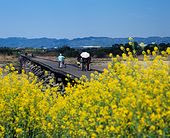 |
| Kozuya Bridge. Map/Location. |
 |
| Kozuya Bridge. Map/Location. |
The image on the right, taken today (Sunday 14th October 2012), is of the same bridge after the forces-of-nature had flexed their muscles.
But, before I explain how one image drastically changed to become the other, let me give you a brief run-down of the bridges history.
The bridges history dates-back several hundred years and spans the Kizugawa River and connects Yawata-shi (city) with Kumiyama-cho (town) in Joyo City. The bridge, at 356-meters long and 3.3-meters wide, is the longest extant wooden bridge in Japan. The modern bridge was constructed in 1953 to replace the ferry service, which was abandoned in 1951. The bridge is a popular stop on the Kizugawa cycle/walkway and, before descending the path, there is a nice shelter/picnic area where the traveller can rest-up and take in the surrounding scenery.
Many festivals are acted-out on the bridge, like the "Jidaigeki Matsuri" Festival, in the image on the left, with participants dressing-up in traditional Japanese costume. One will also witness the occasional television/film crew recording the latest blockbuster here too.
The Kozuya Bridge, also known as the "Nagare Bashi" or "Flowing Bridge" (Nagare meaning flow,and bashi meaning bridge), was constructed in such a way that, whenever the river is flooded, the wooden floor will become afloat and wash-aside to one side of the river where it won't go-against the force of the current and thereby evading total destruction of the bridge. The reason why the wooden floor won't be washed-away, is because each section of the floor (all eight of them) are attached to the pier with wire ropes.
The wooden piers are the only permanent parts of the bridge but, in saying that, they have been known to buckle-under the pressure when the water current has been too strong. Since 1953, when the current bridge was constructed, the bridge has been damaged sixteen times, four of those times in the eight years since I have been in Japan.
I should have mentioned at the beginning of this post that there are two topics I wanted to cover. The second being the destruction caused by the forces of nature. The events of the 7th April 2011 - 2011 Tohoku Earthquake and Tsunami - are still fresh in the minds of many people; I remember watching the events unfold live on television, as did many millions of others, and sat overwhelmed at how houses, boats, motor-vehicles were just swept-aside, as this huge wall of water wiped-out many towns & villages in it's path. This bridge, after a flood, reminds me of the devastation that can be caused by an uncontrolled wall-of-water.
It's difficult to say where the source of the Kizu River is but, looking at a map of the area, it's catchment is quite extensive so, when there is a long/heavy rain, there is sure to be some water flowing down to it's final destination - Osaka Bay.
 |
| The Kozuya Bridge from Kizugawa Cycle/Walkway. Map/Location. |
 |
| Entrance to Bridge. Map/Location. |
 |
| Map/Location. |
The sight of this tree-stump, in this image on the right, brings-into perspective how high the river level must have been ( I am about 4-meters from the top, with about another meter to go, before I reach the river-bed).
 |
| The Wooden Floor. |

In the two images above you get an idea how much debris can be washed-down a river during a flood. I have passed by many rivers after there has been a flood and there are many things that impress me - the amount of water and where it has come from (I am talking about rain here), how suddenly the river-water can rise & recede, and the debris. Wandering-around the bridge, there was very little pickings to sift through. My only hope, looking at the accumulated scrub, that no-one leaves a burning cigarette behind.
 |
| Nagare-bashi at sunrise. |
Links; Video of Kozuya Bridge.
Yawata City.


